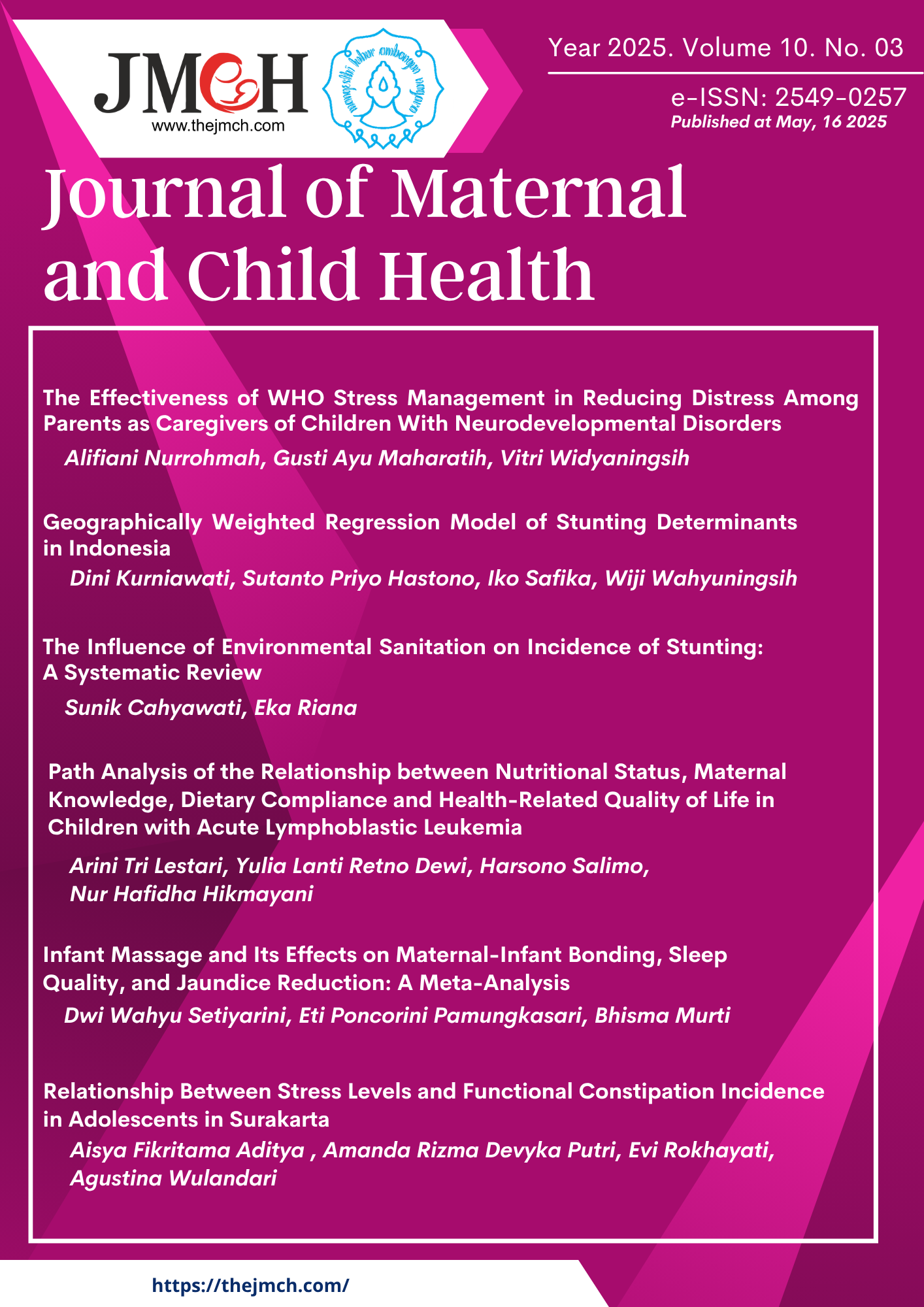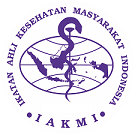The Influence of Environmental Sanitation on Incidence of Stunting: A Systematic Review
DOI:
https://doi.org/10.26911/thejmch.2025.10.03.03Abstract
Background: Stunting is a chronic health problem that has long-term impacts on child growth and development, especially in developing countries. Poor environmental sanitation is believed to be one of the main risk factors; however, this needs to be further examined based on empirical study findings. This study aims to analyze this issue systematically.
Subjects and Method: This is a systematic review using the PRISMA Flow Diagram. The PICO framework includes: Population (P): Children under five years of age; Intervention (I): Poor environmental sanitation; Comparison (C): Adequate environmental sanitation; Outcome (O): Stunting. Articles were retrieved from databases including PubMed, Scopus, ScienceDirect, and Google Scholar. Keywords used were “hygiene AND sanitation AND stunting AND under five AND cross-sectional.” The quality of the studies was assessed using the Joanna Briggs Institute (JBI) Critical Appraisal tool.
Results: A total of 9 articles from four studies were conducted in Asia, all of which from Indonesia, and five studies were conducted in Africa, all of which from the Ethiopia, indicated that access to proper sanitation, clean water, as well as appropriate feces disposal and handwashing practices, are strongly associated with a reduction in stunting incidence. The risk of stunting increases among children living in environments with unimproved latrines, untreated drinking water, and poor hygiene practices. Additional factors such as the child’s age, mother’s education level, and socioeconomic status also influence stunting outcomes.
Conclusion: Inadequate environmental sanitation plays a significant role in the occurrence of stunting. Preventive interventions should prioritize improving sanitation access, promoting hygiene behavior education, and implementing cross-sectoral approaches to sustainably reduce stunting prevalence.
Keywords:
environment, sanitation, stunting, systematic reviewHow to Cite
References
Cameron L, Chase C, Haque S, Joseph G, Pinto R, Wang Q (2021). Childhood stunting and cognitive effects of water and sanitation in Indonesia. Econ Hum Biol. 2021: 40:100944. doi: 10.1016/j.ehb.2020.100944.
Checkley W, Buckley G, Gilman RH, Moulton LH, Psaty BM, Rodriguez S, Humphrey JH (2017). Wasting and stunting are associated with decreased iron absorption in Peruvian infants: a randomized, controlled trial. The American Journal of Clinical Nutrition. 105(2): 332-340.
Cumming O, Cairncross S (2016). Can water, sanitation and hygiene help eliminate stunting? Current evidence and policy implications. Matern Child Nutr. 12 Suppl 1(Suppl 1):91-105. doi: 10.1111/mcn.12258.
Humphrey JH (2019). Child undernutrition, tropical enteropathy, toilets, and handwashing. Lancet. 374(9694):1032-1035. doi: 10.1016/S0140-6736(09)60950-8.
Hurint MTN, Bintari H, Yuliani Y, Kurniasari Y, Rahayu HK, Aji A (2023). Sanitation and Family Environmental Health Status and Its Association with Stunting in Kulon Progo, Indonesia. Journal of Global Nutrition. 3(2): 267–278. https://jurnal.isagi.or.id/index.php/jgn/article/view/65
Ministry of Health (2024). Survei status gizi Indonesia (Survey of nutritional status of Indonesia). Jakarta: Ministry of Health.
Kwami CS, Godfrey S, Gavilan H, Lakhanpaul M, Parikh P (2019). Water, Sanitation, and Hygiene: Linkages with Stunting in Rural Ethiopia. Int J Environ Res Public Health. 16(20):3793. doi: 10.3390/ijerph16203793.
Olo A, Mediani HS, Rakhmawati W (2020). Hubungan faktor air dan sanitasi dengan kejadian stunting pada balita di Indonesia. Jurnal Obsesi: Jurnal Pendidikan Anak Usia Dini, 5(2). https://obsesi.or.id/index.php/obsesi/article/view/788/0Prasetyo, Susanna (2025). Hygiene and sanitation towards the incidence of stunting in children under five years old in Bidara Cina Village, East Jakarta in 2024. International Journal of Advancement in Life Sciences Research.
Rah JH, Sukotjo S, Badgaiyan N, Cronin AA, Torlesse H (2020). Improved sanitation is associated with reduced child stunting amongst Indonesian children under 3 years of age. Matern Child Nutr. 16 Suppl 2(Suppl 2):e12741. doi: 10.1111/mcn.12741.
Soboksa NE, Gari SR, Hailu AB, Alemu BM (2021). Child defecation, feces disposal practices and associated factors in community-led total sanitation adopted districts in Jimma Zone, Ethiopia. Environmental Challenges. https://doi.org/10.1016/j.envc.2021.100059
Syam DM, Bungawati A (2024). The effectiveness of community-led total sanitation cadre intervention in improving stunting knowledge and behavior. Healthcare in Low-resource Settings, 13(s1). https://www.pagepressjournals.org/hls/article/view/13109
Toma TM, Andargie KT, Alula RA, Kebede BM, Gujo MM (2023). Factors associated with wasting and stunting among children aged 06-59 months in South Ari District, Southern Ethiopia: a community-based cross-sectional study. BMC Nutr. 9(1):34. doi: 10.1186/s40795-023-00683-3.
Torlesse H, Cronin AA, Sebayang SK, Nandy R (2016). Determinants of stunting in Indonesian children: evidence from a cross-sectional survey indicate a prominent role for the water, sanitation and hygiene sector in stunting reduction. BMC Public Health. 16:669. doi: 10.1186/s12889-016-3339-8.
UNICEF (2021). Improving young children’s diets during the complementary feeding period. https://www.unicef.org/reports/improving-young-childrens-diets-during-complementary-feeding-period
Woldesenbet B, Tolcha A, Tsegaye B (2023). Water, hygiene and sanitation practices are associated with stunting among children of age 24-59 months in Lemo district, South Ethiopia, in 2021: community based cross sectional study. BMC Nutr. 9(1):17. doi: 10.1186/s40795-023-00677-1.
World Health Organization (WHO) (2020). Malnutrition – Key Facts. https://www.who.int/news-room/fact-sheets/detail/malnutrition










